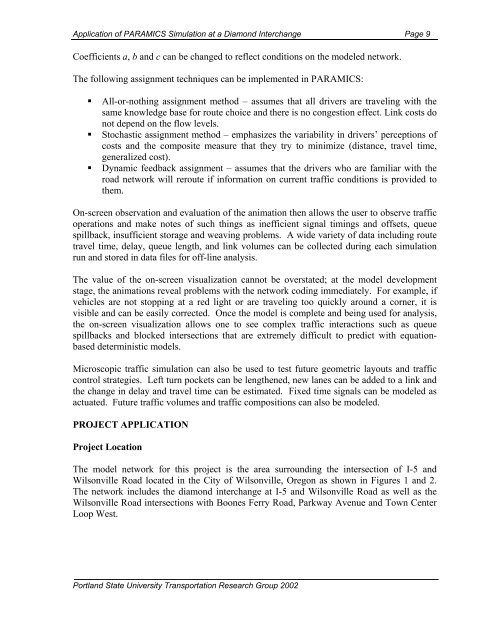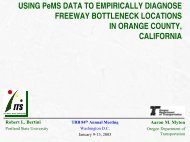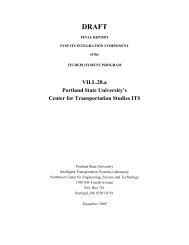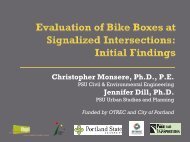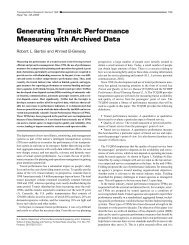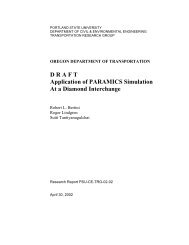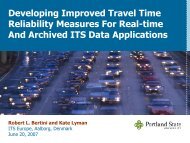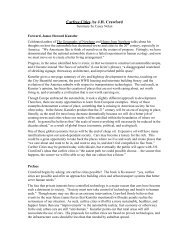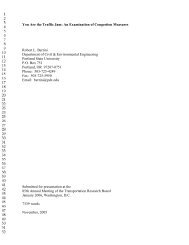D R A F T Application of PARAMICS Simulation At a Diamond ...
D R A F T Application of PARAMICS Simulation At a Diamond ...
D R A F T Application of PARAMICS Simulation At a Diamond ...
You also want an ePaper? Increase the reach of your titles
YUMPU automatically turns print PDFs into web optimized ePapers that Google loves.
<strong>Application</strong> <strong>of</strong> <strong>PARAMICS</strong> <strong>Simulation</strong> at a <strong>Diamond</strong> Interchange Page 9<br />
Coefficients a, b and c can be changed to reflect conditions on the modeled network.<br />
The following assignment techniques can be implemented in <strong>PARAMICS</strong>:<br />
• All-or-nothing assignment method – assumes that all drivers are traveling with the<br />
same knowledge base for route choice and there is no congestion effect. Link costs do<br />
not depend on the flow levels.<br />
• Stochastic assignment method – emphasizes the variability in drivers’ perceptions <strong>of</strong><br />
costs and the composite measure that they try to minimize (distance, travel time,<br />
generalized cost).<br />
• Dynamic feedback assignment – assumes that the drivers who are familiar with the<br />
road network will reroute if information on current traffic conditions is provided to<br />
them.<br />
On-screen observation and evaluation <strong>of</strong> the animation then allows the user to observe traffic<br />
operations and make notes <strong>of</strong> such things as inefficient signal timings and <strong>of</strong>fsets, queue<br />
spillback, insufficient storage and weaving problems. A wide variety <strong>of</strong> data including route<br />
travel time, delay, queue length, and link volumes can be collected during each simulation<br />
run and stored in data files for <strong>of</strong>f-line analysis.<br />
The value <strong>of</strong> the on-screen visualization cannot be overstated; at the model development<br />
stage, the animations reveal problems with the network coding immediately. For example, if<br />
vehicles are not stopping at a red light or are traveling too quickly around a corner, it is<br />
visible and can be easily corrected. Once the model is complete and being used for analysis,<br />
the on-screen visualization allows one to see complex traffic interactions such as queue<br />
spillbacks and blocked intersections that are extremely difficult to predict with equationbased<br />
deterministic models.<br />
Microscopic traffic simulation can also be used to test future geometric layouts and traffic<br />
control strategies. Left turn pockets can be lengthened, new lanes can be added to a link and<br />
the change in delay and travel time can be estimated. Fixed time signals can be modeled as<br />
actuated. Future traffic volumes and traffic compositions can also be modeled.<br />
PROJECT APPLICATION<br />
Project Location<br />
The model network for this project is the area surrounding the intersection <strong>of</strong> I-5 and<br />
Wilsonville Road located in the City <strong>of</strong> Wilsonville, Oregon as shown in Figures 1 and 2.<br />
The network includes the diamond interchange at I-5 and Wilsonville Road as well as the<br />
Wilsonville Road intersections with Boones Ferry Road, Parkway Avenue and Town Center<br />
Loop West.<br />
Portland State University Transportation Research Group 2002


